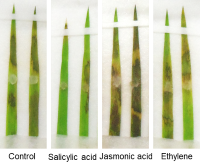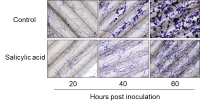Enlarge Image Fig.2. Effect of salicylic acid pretreatment on R. solani hyphal growth (purple filaments) on B. distachyon leaf surface. SA treatment prevents formation of structure called infection cushion (dense clots) required for the progression to its necrotrophic stage.
Enlarge Image Fig.3. Disease symptom (left) and relative fungal biomass inside leaves (right) of three different accessions of B. distachyon Bd21, Bd3-1, and Gaz-4 inoculated with R. solani.
Enlarge Image
Plant science: New insights into infection strategy of Rhizoctonia solani, a causal agent for rice sheath blight, highlighted by the plant defense mechanism
Rhizoctonia solani is a soil-borne phytopathogical fungi causing sheath blight, a major disease in cultivated rice. It gives rise to serious damage in agriculture and economies in USA and East Asia including Japan.
Phytopathogens are classified in terms of their lifestyle and R. solani is regarded as a necrotrophic pathogen which kills its host to obtain nutrients. In contrast, biotrophic pathogens parasitize their hosts to deprive nutrients form living cells. Since all rice cultivars are not fully resistant to R. solani, fungicides are the only current means to deal with this pest..
Yusuke Kouzai, Yoshiteru Noutoshi, and colleagues at Okayama University have developed a pathosystem using R. solani and Brachypodium distachyon, an emerging monocotyledonous model plant, and found that pretreatment of a phytohormone salicylic acid (SA) can induce disease resistance in both B. distachyon and rice against R. solani. Consistently, the SA-deficient transgenic rice is more susceptible to R. solani compared with wild-type.
Furthermore, two accessions of B. distachyon were found to be resistant against R. solani, that activate SA-dependent immunity after inoculation.
These results update the pathogenic program of R. solani as a hemi-biotroph which uses biotrophic phase at the initial invading step where SA-dependent plant immunity can effectively block. In addition, B. distachyon should deploy disease resistance proteins which work as a sensor detecting R. solani to activate defense response.
The researchers proposed two options to counteract this intractable disease: 1. development of R. solani-resistance cultivars using genetic resources of B. distachyon; and 2. development of plant immune-activating chemicals termed plant defense activator with SA-based functionality.
Reference:
Authors
Yusuke Kouzai, Mamiko Kimura, Megumi Watanabe, Kazuki Kusunoki, Daiki Osaka, Tomoko Suzuki, Hidenori Matsui, Mikihiro Yamamoto, Yuki Ichinose, Kazuhiro Toyoda, Takakazu Matsuura, Izumi C. Mori, Takashi Hirayama, Eiichi Minami, Yoko Nishizawa, Komaki Inoue, Yoshihiko Onda, Keiichi Mochida, and Yoshiteru Noutoshi
Title of original paper
Salicylic acid-dependent immunity contributes to resistance against Rhizoctonia solani, a necrotrophic fungal agent of sheath blight, in rice and Brachypodium distachyon.
Journal, volume, pages and year
New Phytologist 217(2), 771-783. (2018)
Digital Object Identifier (DOI)
10.1111/nph.14849
Journal website
http://onlinelibrary.wiley.com/doi/10.1111/nph.14849/full
Affiliations
Graduate School of Environmental and Life Science, Okayama University
Author website
http://noutoshi-lab.com/english/index_e.html




